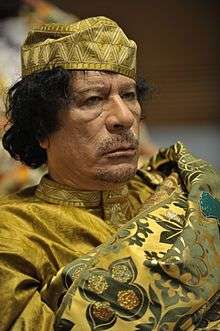Brotherly Leader and Guide of the Revolution
| Brotherly Leader and Guide of the Revolution
الشقيق القائد ومرشد الثورة | |
|---|---|
|
| |
 | |
| Style | His Excellency |
| Residence | Bab al-Azizia, Tripoli |
| Formation | 2 March 1979 |
| First holder | Muammar Gaddafi |
| Final holder | Muammar Gaddafi |
| Abolished | 20 October 2011 |
.svg.png) |
| This article is part of a series on the politics and government of Libya under Muammar Gaddafi |
|
Constitution |
|
Judiciary
|
|
Foreign Policy |
The Brotherly Leader and Guide of the Revolution (Arabic: الشقيق القائد ومرشد الثورة) was an unofficial title held by former Libyan leader Muammar Gaddafi, who claimed to be merely a symbolic figurehead of the country's official governance structure.[1][2] However, critics have long described him as a demagogue,[3] referring to his position as the de jure former political office, despite the Libyan state's denial of him holding any power.[1][2]
History
After the coup d'état on 1 September 1969, in which King Idris I was deposed, Libya was governed by the Revolutionary Command Council (RCC) headed by Gaddafi. On 2 March 1977, after the adoption of the Declaration on the Establishment of the Authority of the People, the RCC was abolished and the supreme power passed into the hands of the General People's Congress.[4] Gaddafi then became Secretary-General of the General People's Congress.
On 2 March 1979, Gaddafi renounced all public functions and was designated the "Leader" (Qāʾid) of the Libyan state and was accorded the honorifics "Guide of the First of September Great Revolution of the Socialist People's Libyan Arab Jamahiriya" or "Brotherly Leader and Guide of the Revolution" in government statements and the official press.[5]
Although this title was officially used only from 1979, it is often applied for the whole period of Gaddafi's rule. Although Gaddafi had no official government function from 1979, it was understood that he exercised near-absolute control over the government and the country. His 42 years in power prior to the civil war in 2011 have made him the fifth longest-ruling non-royal national leader since 1900, as well as the longest-ruling Arab leader.[6]
Although ousted from Tripoli at the end of August 2011, Gaddafi retained this de facto position as leader of the Pro-Gaddafi forces, until his defeat and murder by the Anti-Gaddafi forces in the Battle of Sirte on 20 October 2011.[7]
Political system of Libya under Gaddafi

The Libyan Arab Jamahiriya was formally managed on the basis of political ideology set out in The Green Book. The ideology was based on the idea of direct democracy, and direct decision-making of all citizens on all political matters. Across the country there were the basic people's congresses, which were considered the original holders of sovereignty. These included the composition of its adult citizens - both men and women. Of their managerial and executive bodies formed the municipal people's congresses and committees, and then the General People's Congress (legislative body) and the General People's Committee (executive body).
Gaddafi rejected the parliamentary representation of the people or by elected representatives, as the General People's Congress was seen as a coordinating body that brought together all the popular congresses and committees, and not elected members who made decisions on behalf of the people. All laws were approved by the basic people's congresses, and then finally adopted by the General People's Congress.
Timeline

| Numerical order | Supreme Rule | Portrait | Name English · Arabic · Signature |
Lifespan | Place of birth | Political Party | Notes | ||
|---|---|---|---|---|---|---|---|---|---|
| Ideology | |||||||||
| 1 | 1 September 1969 – 20 October 2011 (42 years, 49 days) |
 |
Colonel Muammar Gaddafi مُعَمَّر القَذَّافِي  |
7 June 1942[8] – 20 October 2011 (aged 69) | Qasr Abu Hadi, Sirte, Tripolitania Province | Arab Socialist Union (1971–1977) |
Leader of the 1969 coup d'état, and founder of the Libyan Arab Jamahiriya. | ||
| Third International Theory (early 1970s–2011) | |||||||||
See also
References
- 1 2 Wynne-Jones, Jonathan (19 March 2011). "Libyan minister claims Gaddafi is powerless and the ceasefire is 'solid'". The Daily Telegraph. London. Retrieved 22 October 2011.
- 1 2 "Gaddafi: Libya dignity under attack". Al Jazeera. 2 March 2011. Retrieved 22 October 2011.
- ↑ Bazzi, Mohamad (27 May 2011). "What Did Qaddafi's Green Book Really Say?". The New York Times. Retrieved 28 October 2011.
- ↑ Text of the Declaration (English)
- ↑ US Department of State's Background Notes, (Nov. 2005) "Libya - History", U.S. Dept. of State, Accessed July 14, 2006
- ↑ Charles Féraud, "Annales Tripolitaines", the Arabic version named "Al Hawliyat Al Libiya", translated to Arabic by Mohammed Abdel Karim El Wafi, Dar el Ferjani, Tripoli, Libya, vol. 3, p.797.
- ↑ "Muammar Gaddafi killed in Sirte". Al Jazeera English. 2011-10-20. Retrieved 2011-10-20.
- ↑ "Where green refuses to fade". The Economist. 29 June 2013. Retrieved 11 September 2016.